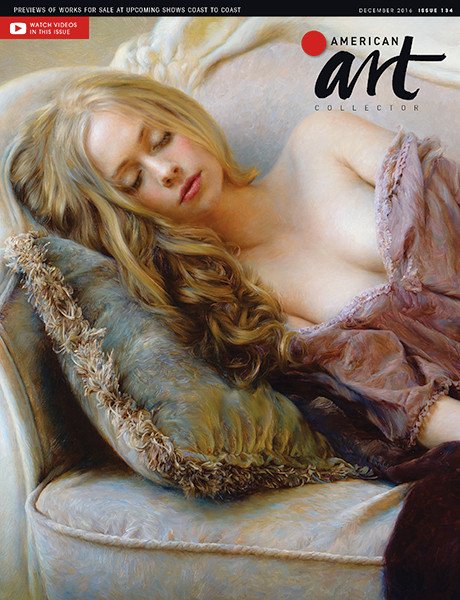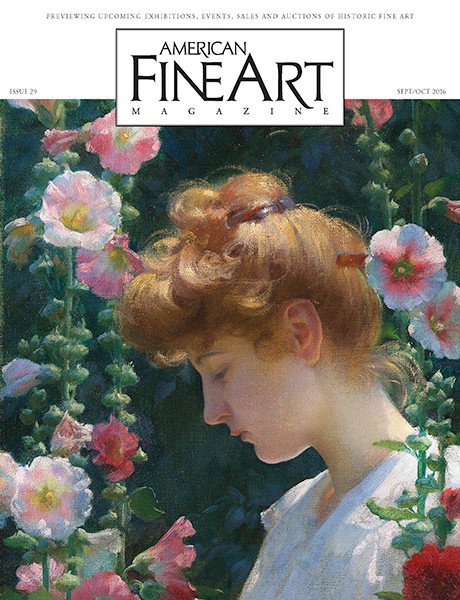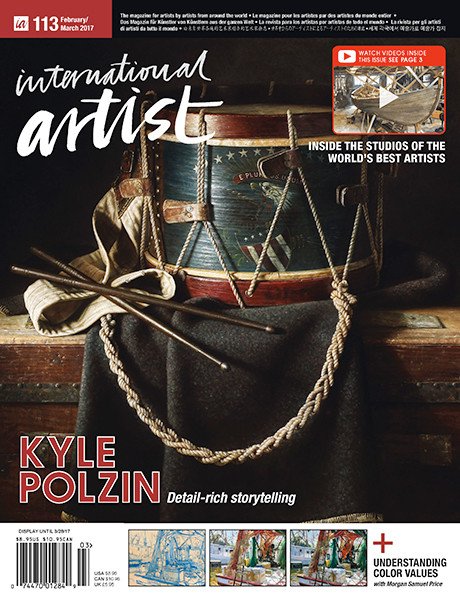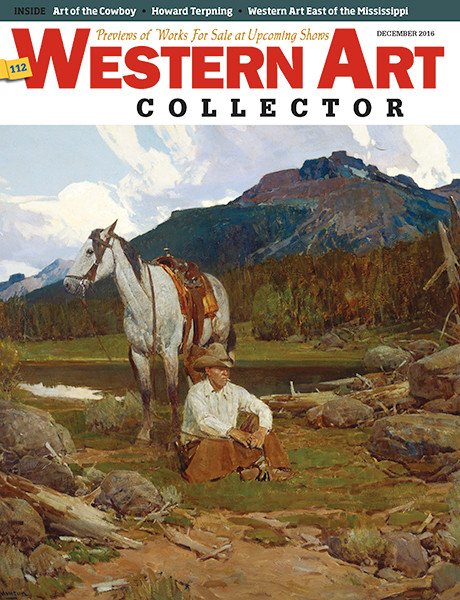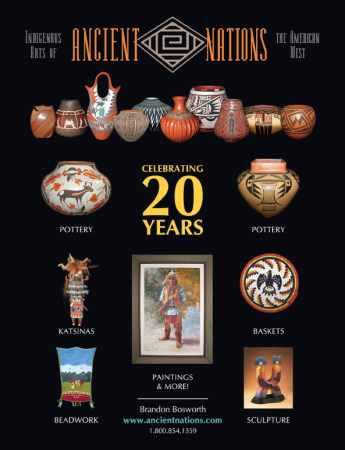Ancient Nations: Indigenous Arts
2242 Washington BlvdOgden, UT 84401
1.800.854.1359
Email this Gallery
Visit Gallery Website
Ancient Nations: Indigenous Arts
1/13/2020 - 3/31/2020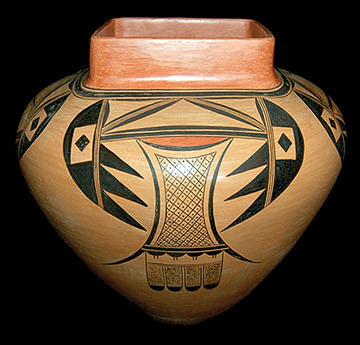
A. Kiva Wing Vase
Tonita Nampeyo
Hopi Pueblo Pottery
13.5 x 12.5 inches (L x W)
This special piece was made especially for our private collection while we were located in Keams Canyon, Arizona - on the Hopi Indian Reservation. It is one of the largest vessels (if not the absolute largest) Tonita has ever created - and easily the largest we have ever offered. (See more about Tonita and this piece, along with additional images and pricing on our website.)
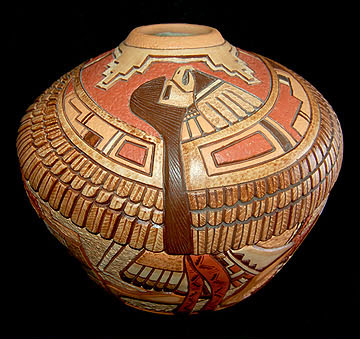
B. Grand Guardian
Tom Polacca
Hopi Pueblo Pottery
10.5 x 11 inches (L x W)
This special piece was made for us the year before we opened our gallery. It was one of the largest vessels Tom ever created - and easily the largest we have ever offered. It represents the pinnacle of Tom's work in this style - which was hallmark of a career for which he was well known. It has been lovingly cared for and admired for many years. As we celebrate our 20th Anniversary, we are presenting select items from our private collection for the very first time. (Read more and view additional images, along with pricing, on our website.)
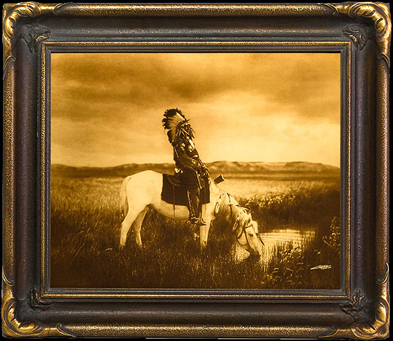
Cardozo Goldtone - An Oasis in the Badlands
Edward S. Curtis
Goldtone Photograph
18 x 22 inches (L x W)
Christopher Cardozo is widely acknowledged as the world’s leading authority on Edward S. Curtis. He is the author of nine monographs on Edward Curtis and has created and curated one-person Edward Curtis exhibitions that have been seen in nearly one hundred venues in over forty countries.
Having collected Edward Curtis’ artwork for four decades, Cardozo has created the world’s largest and most broad-ranging Curtis collection. No one has done more to increase the awareness, understanding, and appreciation for Curtis’ work than Christopher Cardozo, except Edward Curtis himself.
Cardozo reinvented the lost Goldtone process from the ground up, marrying the best of modern technology using Curtis’ exquisite negatives. Goal: to consistently produce stunning Goldtones as good as the top half percent of Edward Curtis’ vintage Goldtones. Cardozo spent over three years and nearly half a million dollars on research and development. Each framed and printed image is individually hand-created, together encompassing over 70 different steps. (Read more about this image, along with pricing, on our website.)

Crow Mother Coil Plaque
Artist Unknown
Hopi Basket
14.5 x 14.5 inches (L x W)
Where baskets were once a common item among all tribes, the art has now disappeared among many Native Americans, and the handful of weavers that continue this ancient craft are few and far between. Hopi basket weavers are considered some of the best in North America. They produce baskets in three different techniques. On Second Mesa the Hopi weavers specialize in Hopi Coil basketry. Hopi coiled baskets are woven by wrapping bundles of plant material with a single piece of plant material usually yucca. The colors are usually limited to white, yellow, green, red and black. Designs you often find on these beautiful baskets are Katsina, animals, blanket, and geometric designs.(Read more and view additional images, along with pricing, on our website.)
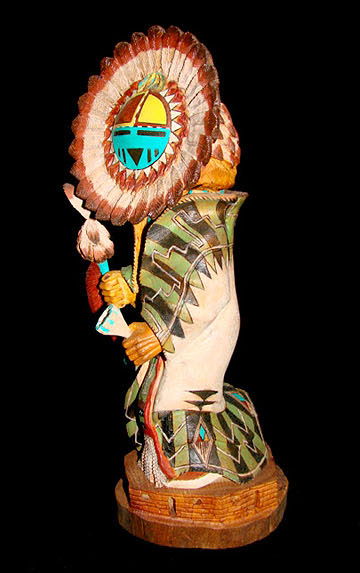
Dawa Sun
Harriet Navasie
Hopi Kachina
14.5 x 4.5 inches (L x W)
According to Barton Wright, "the Sun Kachina [Dawa] is a representation of the spirit of the Sun, though on occasion be called the Sun Shield Kachina. He appears in a role very similar to that of the Nakiachop or Talavai, standing to the side with a spruce tree in his left hand and a bell in his right.
Also, he may appear in a Mixed Dance with the flute in his left hand that is associated with him in many myths. He is not often personated."
- Barton Wright, Kachinas: a Hopi Artist's Documentary (124) (Read more and view additional images, along with pricing, on our website.)
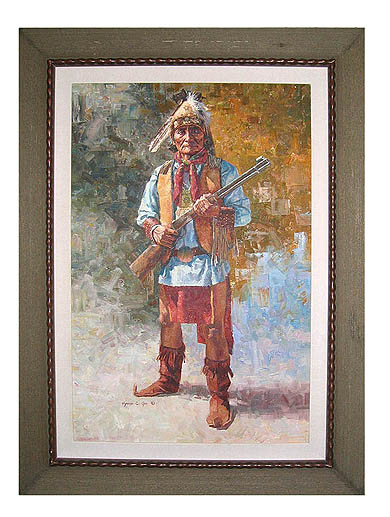
Geronimo - Apache Medicine
Hyrum Joe
Original Oil
47 x 35 inches (L x W)
Born in 1979 in Farmington, NM and raised on the Navajo Indian Reservation in Shiprock, NM, Hyrum grew up in a family of Native American artists. Among them, he has received a great amount of inspiration from his father, Oreland C. Joe Sr., a well known bronze and stone sculptor. After graduation from Kirtland Central High School, he studied figurative charcoal drawing and oil painting at Mesa Community College in Mesa, AZ under instructor Jim Garrison who taught with a deep admiration of the influences of the 19th century "European Masters." There, Hyrum was quickly drawn into his favorite subject matter, painting the Southwest Indian cultures and unique lifestyles from 1850-1950, a time period that is intriguing to him and is still somewhat accessible.
He has recently participated in various art shows in New Mexico and Arizona including the more premiere shows of Santa Fe Indian Market, the Heard Museum Guild Indian Market and the George Phippen Memorial Western Art Show.
Today, Hyrum gets his inspiration by seeking to live what he paints. Whether his paintings depict a couple of Northern Traditional Dancers at a pow wow, or an elderly Navajo couple at a Squaw Dance, he feel's a need to be there, dancing, to get a true feeling and sense of what it is has been like through years of history. In addition to his influence, Hyrum has studied, as well as appreciated the works of "Master Painter", Howard Terpning, Figure Painter Ned Jacob, and the late Christian-theme painter, Harry Anderson. In addition to his mainly Navajo ancestry, Hyrum also has Southern Ute ancestry from his father, Hopi blood from both his mother and father's sides and even some White Mountain Apache from his mother's side. (Read more and view additional images, along with pricing, on our website.)
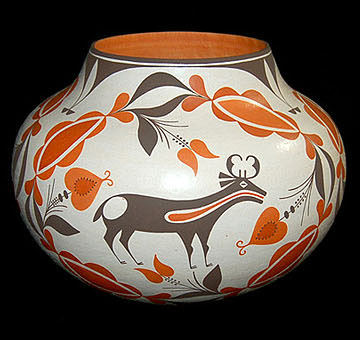
Grand Acoma Olla
Joseph Cerno Jr.
Pueblo Pottery
10 x 13.5 inches (L x W)
Born in 1972, Joseph Cerno Jr. is the son of Barbara and Joe Cerno, Sr. of Acoma Pueblo. Joseph learned the art of pottery making from his grandmother, Santana Cimmeron Cerno, and his father, Joseph Cerno, Sr. Joseph is an outstanding potter and painter of pottery as well.
This particular piece has a striking bulbous shape at the shoulder and an extremely commanding presence. At nearly fourteen inches in diameter, it becomes the focal point of any grouping. (Read more and view additional images, along with pricing, on our website.)
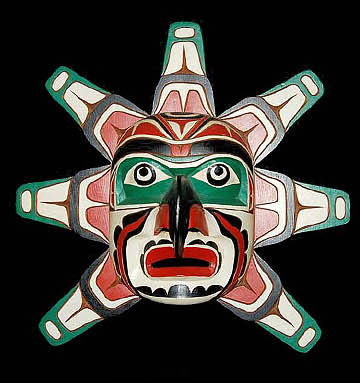
Hawk Sun Mask
Gary Rice
Northwest Coastal Carving
21 x 21 x 7.5 inches (L x W x D)
Gary Rice was born June 30, 1939 in a fishing village in Rivers Inlet on the central coast of British Columbia. Mr. Rice is a member of the Coast Salish Nation. He finds satisfaction in carrying on the traditions of his ancestors and is a patient and dedicated carver. Gary is adept at various forms including screens, masks, bowls, paddles, and totem poles. To the people of the Northwest Coast, the sun is a symbol of life. It is not an extremely common crest, except amongst the Kwakwaka’wakw. Sun is depicted within the art as a circle with protruding rays. It is commonly depicted as masculine; however, sun is occasionally displayed as female. (Read more and view additional images, along with pricing, on our website.)
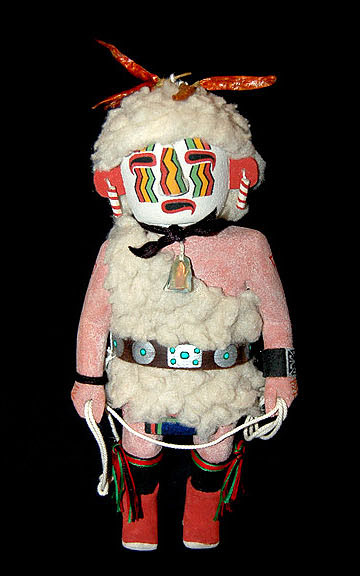
Heyheya
Raymond Naha
Traditional Hopi Katsina
10.5 x 3.5 inches (L x W)
The Heheya kachina has no English name or translation. Heheya Kachinas are most often seen on Third Mesa and act as messengers to the rain gods. The Heheyas dance on the side of the procession and guard the other dancers. He talks in opposites...for instance, if the dance is good, he says it is bad.
Heheyas are easily recognized by the vertical red, yellow and blue zigzag lines on the sides of the mask. The pothook eyes are black, outlined in red and the mouth is a similar pothook style. The case mask is painted yellow and there is a grouping of red chili peppers on top of the mask. He has red tab ears and he wears a black and white cloth ruff.
He wears a sheepskin tunic draped over his right shoulder and he also wears a folded black breechclout underneath. He has knitted leggings with straps and red moccasins. (Read more and view additional images, along with pricing, on our website.)
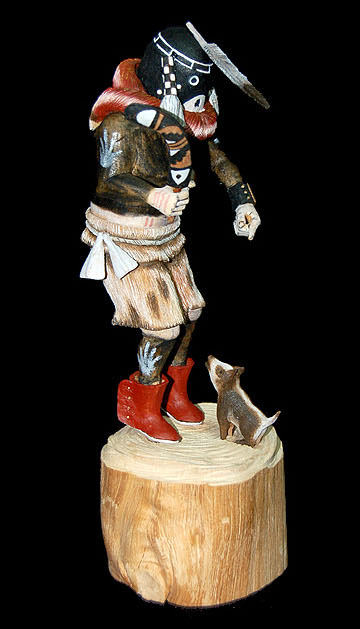
Mastop
David Jensen
Hopi Kachina
11 x 3.25 inches (L x W)
David Jensen has been carving since 1994 after serving 4 years in the US Navy aboard the USS Kitty Hawk during the US-Iraq conflict, Operation Desert Storm. David first started as do most carvers by whittling with scrap wood that fellow carver Reggie Curry would have around his carving shed.
"He inspired me by giving me my first piece of cotton wood root and encouraging me to give it a try, which was my first sculpture that I sold to my uncle Cecil Calnimptewa when he still had his gallery. With that I purchased my first Foredom and started carving with cousins Arthur Jr. and Arnold Holmes. They would instruct me and give me pointer and technique. When I do get a chance I enjoy carving with them and also with Cecil. (Read more and view additional images, along with pricing, on our website.)
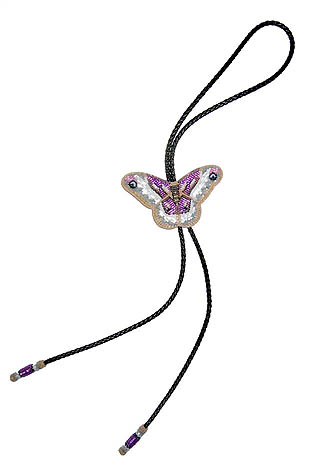
Promethea Bolo
Todd Lonedog Bordeaux
Plains Indian Jewelry
2.25 x 3.5 inches (L x W)
Todd is a member of the Rosebud Sioux Tribe. This award-winning, self-taught artist continues to perfect his craft by learning from his father, Ted Bordeaux.
Among his accolades are awards for Best of Show in 1999 at the Black Hills Art Expo and the Artist Choice Award at Indigenous Peoples Art Market in 2001. Bordeaux boasts 14 awards in seven juried art shows. His jewelry and beadwork art is highly sought after by celebrities and collectors alike. Measures 18" total length. (Read more and view additional images, along with pricing, on our website.)
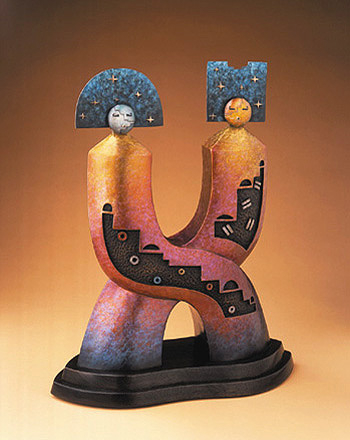
Relationship - The Eternal Journey
Joe Cajero
Bronze
25.5 x 17.5 x 7.5 inches (L x W x D)
The sculpture is two-sided, meaning to represent the physical world on one side and the spiritual on the other. This duality is most specifically noted in the headdresses of the two figures. The night sky, full of stars, represents that part of the universe which is untouchable except through the spirit. The butterflies (feminine) and the dragonflies (masculine) both experience a metamorphosis in life. They represent the physical world, the earth on which we live. The moon is another symbol of femininity, while the sun represents masculinity. (Read more and view additional images, along with pricing, on our website.)
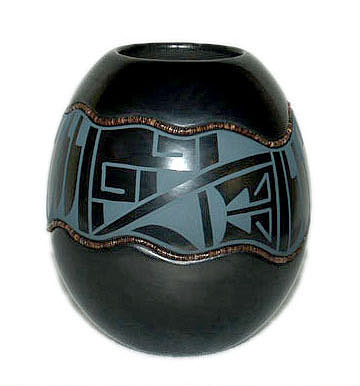
Rio Grande
Erik Fender
Pueblo Pottery
5.5 x 4.75 inches (L x W)
Erik Fender was born in 1970 into the San Ildefonso Pueblo. He specializes in traditional and contemporary blackware pottery.
He started the art of pottery making by watching his grandmother, Carmelita Dunlap, as she would hand coil and hand paint her traditional black -on-black pottery. As he grew older, he started to experiment more with various techniques and clays.
His style progressed from the traditional black-on-black pottery to an innovated two tone, black-on-red, separated by sgraffito low relief carving. He also makes beautiful polychrome pots and presently he specializes in green-on-black pots. (Read more and view additional images, along with pricing, on our website.)
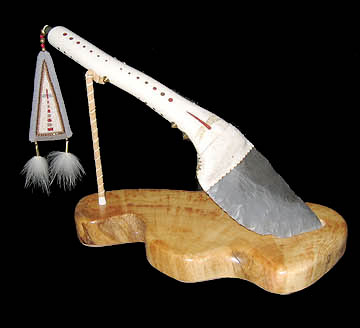
Sacred Offerings
Todd Lonedog Bordeaux
Plains Indian Artwork
7.75 x 13 x 3 inches (L x W x D)
Todd is a member of the Rosebud Sioux Tribe. This award-winning, self-taught artist continues to perfect his craft by learning from his father, Ted Bordeaux.
Among his accolades are awards for Best of Show in 1999 at the Black Hills Art Expo and the Artist Choice Award at Indigenous Peoples Art Market in 2001. Bordeaux boasts 14 awards in seven juried art shows. His jewelry and beadwork art is highly sought after by celebrities and collectors alike.
This impressive piece is an original creation featuring a deer anlter handle inlaid with crushed opal, pipestone, and mammoth ivory. Also there is deer rawhide, brass tacks, brass beads, Czech and Japanese seed beads (dk red, cream, med grey, dk grey, tan, and bronze), and rabbit fur on the ends. The stand is made with Manitoba Maple (box elder), steel, and leather.
The knife is 19 inches long from the tip of the blade to the fur at the end of the beadwork. The blade itself is 2 5/8 inches wide. In the stand, it rises to 8 inches tall, 12 1/2 inches long and 5 inches wide. (View additional images, along with pricing, on our website.)
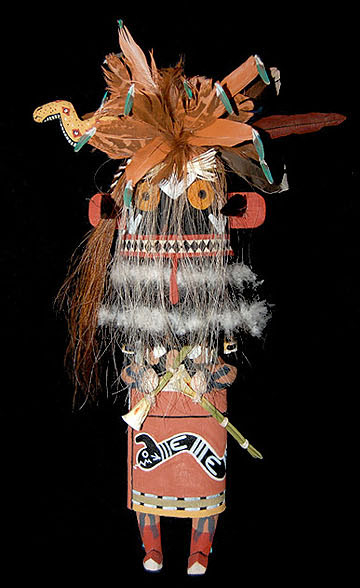
Saviki
Justice Tso
Traditional Hopi Katsina
15.5 x 4.75 inches (L x W)
"The name of this kachina often changes from mesa to mesa. As Teanau, one of the old ones of the Bakab (Reed) Clan at First Mesa, he appears during the March ceremonies, or during the Ankwati when the Water Serpent is carried down to the spring for certain rites.
In this role Tcanau appears as four individuals who are guardians for the Palolokong. His role on Second Mesa is unknown, but on Third Mesa he again appears as a guardian. Under the name of Saviki he is one of the Bow Clan ancients and appears as a single individual with Tangik'china and tow Kokoshoya when the Salako comes in person during Ankwati.
The snake that the kachina carries in his mouth is a bull snake, and generally there is a lizard above his eyes."
- Barton Wright, Kachinas: a Hopi Artist Documentary, (96) (View additional images, along with pricing, on our website.)
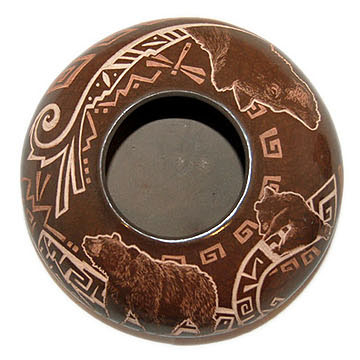
Scamper & Scavenge
Johnathan Naranjo
Pueblo Pottery
2.25 x 5.25 inches (L x W)
Born into Santa Clara Pueblo in 1987, Johnathan Naranjo is the son of Forrest Naranjo and grandson of Bernice Naranjo. He is one of the next generation of potters bridging the gap between ancient traditions and contemporary life.
He began working with clay early in life and developed his own distinctive style. Johnathan has also developed a keen sense as to when to pull something from the fire in order to get a dark brown product rather than the usual black. Then he uses his sgraffito tools to add a mix of contemporary and traditional designs. (Read more and view additional images, along with pricing, on our website.)
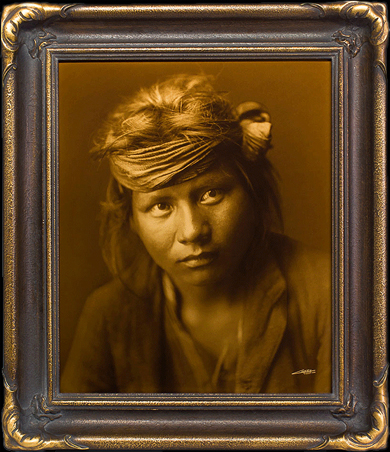
Son of the Desert
Edward S. Curtis
Goldtone Photograph
17 x 14 inches (L x W)
Christopher Cardozo is widely acknowledged as the world’s leading authority on Edward S. Curtis. He is the author of nine monographs on Edward Curtis and has created and curated one-person Edward Curtis exhibitions that have been seen in nearly one hundred venues in over forty countries.
Having collected Edward Curtis’ artwork for four decades, Cardozo has created the world’s largest and most broad-ranging Curtis collection. No one has done more to increase the awareness, understanding, and appreciation for Curtis’ work than Christopher Cardozo, except Edward Curtis himself.
Cardozo reinvented the lost Goldtone process from the ground up, marrying the best of modern technology using Curtis’ exquisite negatives. Goal: to consistently produce stunning Goldtones as good as the top half percent of Edward Curtis’ vintage Goldtones. Cardozo spent over three years and nearly half a million dollars on research and development. Each framed and printed image is individually hand-created, together encompassing over 70 different steps. (Read more about this image, along with pricing, on our website.)
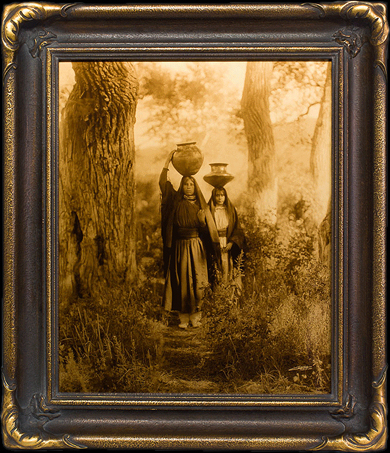
Taos Water Girls
Edward S. Curtis
Goldtone Photograph
17 x 14 inches (L x W)
Christopher Cardozo is widely acknowledged as the world’s leading authority on Edward S. Curtis. He is the author of nine monographs on Edward Curtis and has created and curated one-person Edward Curtis exhibitions that have been seen in nearly one hundred venues in over forty countries.
Having collected Edward Curtis’ artwork for four decades, Cardozo has created the world’s largest and most broad-ranging Curtis collection. No one has done more to increase the awareness, understanding, and appreciation for Curtis’ work than Christopher Cardozo, except Edward Curtis himself.
Cardozo reinvented the lost Goldtone process from the ground up, marrying the best of modern technology using Curtis’ exquisite negatives. Goal: to consistently produce stunning Goldtones as good as the top half percent of Edward Curtis’ vintage Goldtones. Cardozo spent over three years and nearly half a million dollars on research and development. Each framed and printed image is individually hand-created, together encompassing over 70 different steps. (Read more about this image, along with pricing, on our website.)
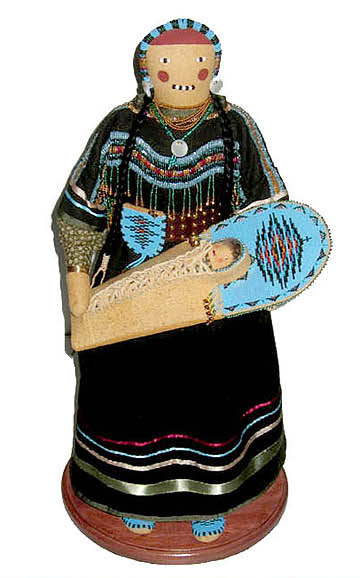
Traditional Blackfeet Doll
Jackie Bread
Plains Indian Beadwork
23.5 x 7.5 inches (L x W)
As a young girl growing up on the Blackfeet Reservation, in Montana, Jackie Larson Bread taught herself the time-consuming and delicate art of beading by watching her grandmother.
Jackie attended the Institute of American Indian Arts in Santa Fe, New Mexico earning degrees in two-dimensional arts and museum studies.
Blackfeet beadwork always remained an interest and was incorporated into her painting and printmaking. While at IAIA, Jackie helped develop illusionary pictorial beadwork, where pictorial depth is created by using different graduated shades of beads. (Read more and view additional images, along with pricing, on our website.)
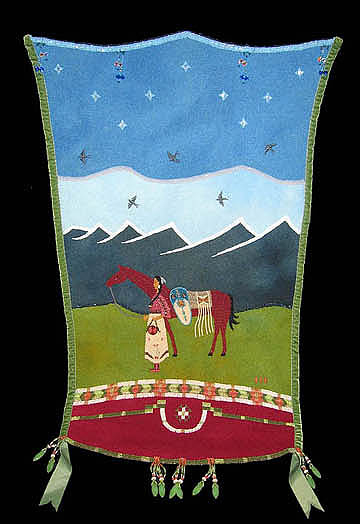
Trek to Turtle Island
Molly Murphy
Plains Indian Beadwork
29 x 17 inches (L x W)
Molly Murphy was born in 1977 in Great Falls, MT. A mixed blood descendant of the Oglala, Lakota tribe, Murphy was raised in western Montana and earned a Bachelor's in Fine Arts from The University of Montana in 2004. Most of her work stems from a combination of traditional Native arts and modern art. Murphy learned beadwork at a very early age as well as hide tanning, sewing and traditional clothing design. This image is an amalgamation of several myths, all related to a first woman and her child and their journey to to Turtle Island. The wall hanging depicts a mother, child and horse walking through a mountain landscape. The sky displays in a mountain pattern with swallows flying. The mother is leading her horse with the child's cradle board hanging from the saddle. Behind the saddle blanket dangles a fringed parfleche pouch. Below the figures is an arch of beadwork similar to the beadwork on the front of women's dresses. (Read more and view additional images, along with pricing, on our website.)
